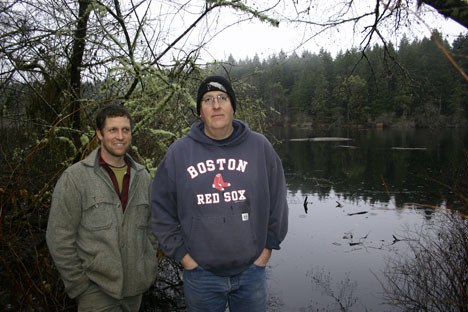In his six years as the steward for Vashon’s only land trust, Abel Eckhardt has witnessed a slow but steady change at Fisher Pond.
What he calls “soil mats,” islands of decomposing plant matter, have begun to appear on the small pond on Bank Road. He saw none of the mats when he started working at the Vashon-Maury Island Land Trust. Now, he says, there are five or six of these floating swaths.
Gary Shugart, an ecologist who has spent hours slogging through the shallow pond as part of his research into its amphibian life, says he has noticed the changes, too.
“I’ve done a lot of walking around in the pond. Because of all the pond weed, … it’s gotten harder to walk through it,” he said.
Fisher Pond, owned and protected by the land trust, was bequeathed to the Island organization more than a decade ago — a gift from Bill Fisher who, on a lineman’s salary, carefully amassed some 90 acres of pond, forest and meadow. Fisher, a man of modest means who lived in an apartment above the metal shed at the west end of the pond, gave his holdings to the land trust in 1998.
Today, it stands as an Island icon — frequented by wood ducks and pied-billed grebes, beloved by Islanders, especially in the heart of winter, when it freezes solid and is transformed into an outdoor skating rink.
And slowly, ecologists say, it is filling in.
Such an ecological succession, called, in this instance, eutrophication, is normal. Over time, if left to its own devices, the pond will spawn more soil mats; they’ll begin to sprout reeds and sedges. Eventually, the 14-acre pond will become a marsh. Many years down the road — Tom Dean, the land trust’s executive director, says likely not in his lifetime — the pond will morph into a soggy, open meadow. Willows will take root. A forest will eventually replace it.
Some believe the land trust should do what it can to keep Fisher Pond a pond. Jill Janow, an Islander who wrote a letter to the editor in last week’s issue of The Beachcomber, urges such an approach.
“I think that pond is one of the finest areas on Vashon,” she said. “The view of it changes minute by minute, day by day, month by month. … Light plays off the water. … It’s just so wonderful to have it there.”
“There’s such a difference between a prairie and a pond,” she added. “It’s just another world.”
But Dean and Eckhardt say such issues raise tough questions for ecologists, whose orientation, often, is not to interfere with ecological processes.
The pond is now home to an array of amphibians, including red-legged frogs, rough-skinned newts and long-toed salamanders. “You see more birds there than anywhere else,” Shugart added.
But if it becomes what ecologists call an emergent wetland, it will host other important life forms, including native plants such as Labrador tea and another suite of amphibians, birds and small mammals, Dean said.
“You’re always trading off one species for another,” he said.
The costs of keeping Fisher Pond a place of open water could be high, he said. Dredging is complex and expensive, and King County likely wouldn’t allow it. Bob Fuerstenberg, a senior ecologist with the county’s Department of Natural Resources and Parks, said there are chemical treatments that can keep the process of eutrophication at bay. Alum, for instance, is often used in the Midwest to keep ponds clear of plant life. But such interventions can have unintended consequences, he noted.
The pond is the headwaters for Shinglemill Creek, which supports salmon and other animals. A chemical or dredging treatment could affect Shinglemill and, in turn, Fern Cove, where Shinglemill flows into Puget Sound.
“You’d have to worry about the downstream effects,” Fuerstenberg said.
“You’d have to develop a pond management plan. That’s how they do it in other parts of the country. But it’s not a simple task,” he added.
Fisher Pond is not natural, Dean and others pointed out. At some point, it was dammed, creating the open water that’s now there. In fact, Dean said, there likely weren’t any open ponds or lakes on Vashon until people started creating them. The Island’s geology — gravelly and porous — doesn’t lend itself to standing pools of water, he said.
Dean said he’s sympathetic to the aesthetics of an open pond. Last month, when the community turned out to skate on the pond’s frozen surface, he was there, too, with his young son. How to handle its slow transformation is a question, he added, that the land trust will likely grapple with for some time.
“I would like to watch this play out for a few more years,” he said, “and see just how rapid the growth is.”



